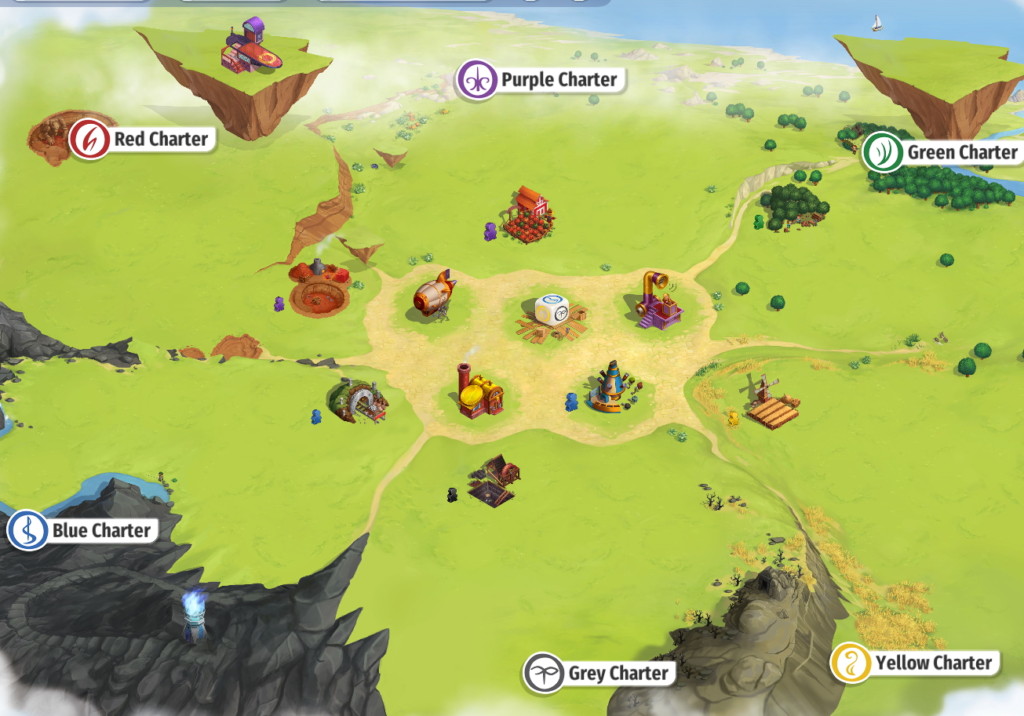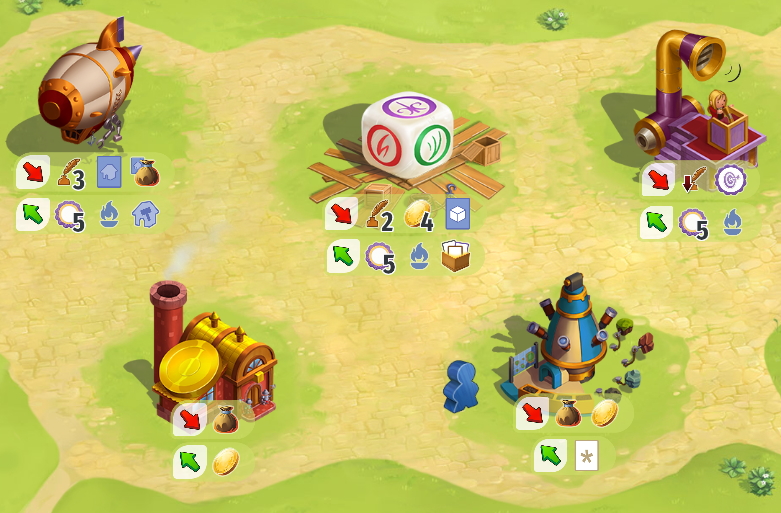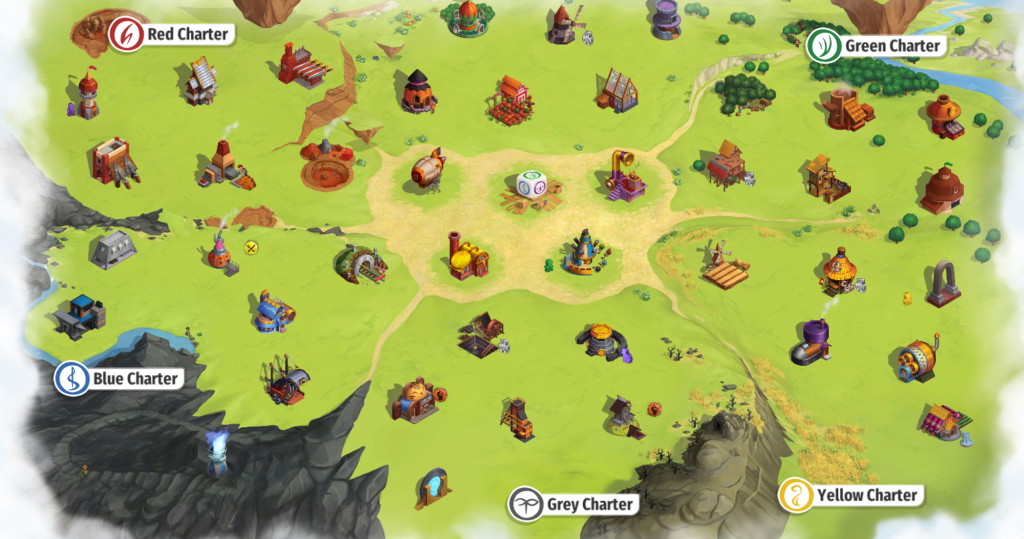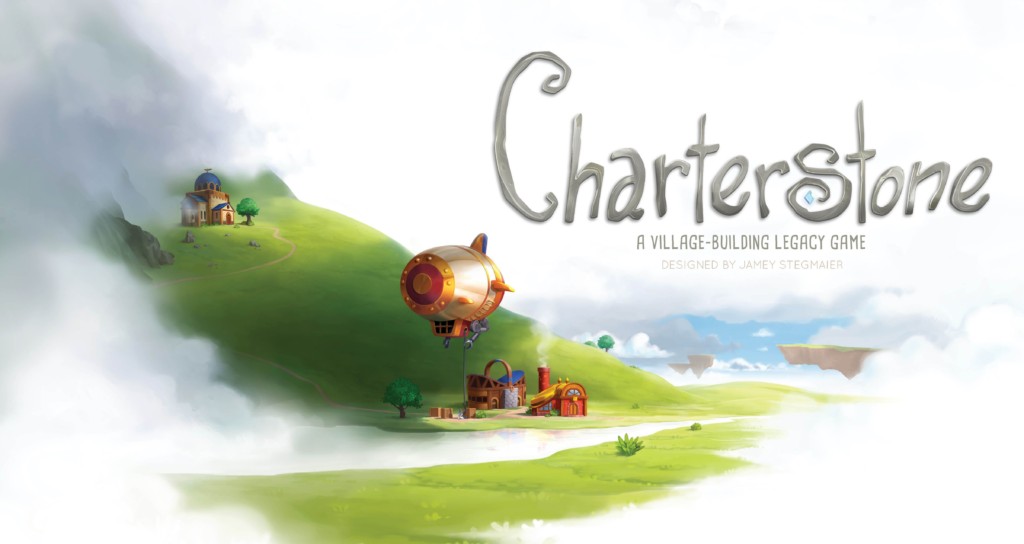Charterstone First Impressions (Spoiler Free)
Charterstone is a board game I wanted to play since release but getting a regular group to commit to a Legacy campaign is hard…
So, I played it on Steam instead!
The prosperous Kingdom of Greengully, ruled for centuries by the Forever King, has issued a decree to its citizens to colonize the vast lands beyond its borders. In an effort to start a new village, the Forever King has selected six citizens for the task, each of whom has a unique set of skills they use to build their charter.
Charterstone Game Play
This is just the general gameplay overview with no spoilers. I do not include any detail or anything after the first game you play in the campaign.
At the end of this article, after a spoiler banner, I list very general hints as to the kind of things you see later in the game
Starting Board & Setup
The board starts pretty emptily with 5 communal buildings in the centre called “The Commons” and 1 off to the side “In the sky”. The rest of the board is divided into 6 Charters, one for each player.

Each player also has one starting building in their area that each gives one of the basic resources: Clay, Pumpkin, Wood, Grain, Coal and Metal.
Players start with 2 workers, 4 coins and 12 Influence.
Core Game Play Mechanism
The core gameplay is a very simple worker placement mechanism.
You place a worker from your supply onto a building, pay the costs listed on that building (if any) and receive the benefits.
On your turn, if you don’t have any workers in hand you return them all from the board. But, if there is already a worker on the building you activate, you bounce that worker back to its owner’s hand.
Building Abilities
The players starting buildings are your basic building. Each of the six starting buildings gives one each of the six starting resources.
The commons buildings do a bit more:

Treasury – Sell a resource for 1 coin
Market – Gain a card from the advancement mat. These are a row of cards you can use to improve your Charter.
Zeppelin – Pay 3 Influence and the cost of a building card in resources to build it in your Charter.
Charterstone – Pay 2 Influence, 4 Coins and a Crate card to gain 5 points and ‘open’ the contents of the crate.
Grandstand – Pay 1 Influence to gain the benefit of one revealed Objective card.
Cloud Port – Trade goods for victory points.
The crates you open with the Charterstone action give you access to more buildings and other things I won’t spoil.
Reputation & Progress Tracks
Certain actions allow you to move up the Reputation track. This is worth end-game points depending on your position on the track at the end of the round.
Some actions also add to the Progress track, it also moves if you start a turn with 0 Influence. When this track gets to the end, the game ends.
End of Round
The player with the most points wins the current game. A campaign is 12 games long.
Theme
It’s nice and cute.
I’m not sure the theme behind the game comes through but you do feel like you own those buildings in your Charter. I can say “That area of the board was crafted by me!”.

As the lord of all Pumpkins, I did want to keep a food theme in my sixth of the board where possible. No strategic reason behind that, just wanting to stay on brand.
Charterstone Summary
I don’t play many worker placement games, I don’t even own one currently.
But the fact the game is simple yet deep, pretty, and resources tight reminded me of Tapestry. A very different game but from the same publisher.
The game at the beginning is pretty good. You’re gaining resources, building buildings and opening crates discovering a tonne of new content.
But for me, later on, there was a lot to concentrate on and remember. This is especially true in a digital version where your cards are not laid out to refer to. They’re hidden behind a menu, even then they need to be clicked to be read.
I did like the basic resource management and the choices you have for those resources. Lots of things give you points but you don’t want to waste any so… what do you do? what’s best right now?
Managing the Influence is fun too. You need it for strong actions in the game but you don’t have a lot. If you’re planning a move later you need to keep in mind how much influence it costs so you have it when you need it.
Overall, this is a fairly enjoyable but average digital game for me. But, with 5 people and the real game, I really think I would enjoy a full campaign.
Jesta ThaRogue
Charterstone Mild Spoilers
WARNING: Below is a brief list of a few things I’ve seen 5 games in.

Limitations – You can only carry 1 of each resource to the next round after round 2
Storage – You increase the number of resources and cards you carry over round to round
Personas – Ongoing special abilities that are also worth end campaign points. There are many different types of Persona
Minions – Different types of worker meeples that have different abilities
Perils – Some buildings give tokens that can be spent to take more advanced actions
Income – Some personas give you income during an income phase (Not actually sure what triggers an income phase)
Goals & Guideposts – Future games have additional ways to score points for that game only
Temporary Rules – Some rounds have rules that only apply to that round
Sky Islands – Replace two buildings with “Sky Islands”
At the end of the campaign, you get points for Glory, Capacity, Buildings, Personas and Games Won.

